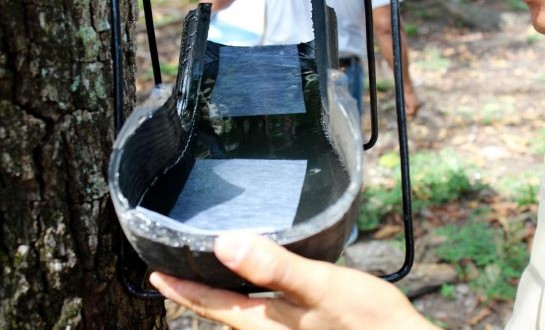Mosquitoes aren’t just an itchy menace: they carry all sorts of diseases, including the Zika virus, which is plaguing large parts of the Americas and other countries around the world. Now, a team from Canada and Mexico has designed an environmentally friendly, low-cost way of fighting them: an egg trap made of old car tires and milk.
The 10-month study, conducted in a remote, urban area of Guatemala, shows the successful development and implementation of a cheap, easy system to stop the spread of virus-carrying Aedes genus mosquitoes by capturing and destroying its eggs.
The system includes an innovative Canadian-designed trap called an “ovillanta,” created from two 50 cm sections of an old car tire, fashioned into a mouth-like shape, with a fluid release valve at the bottom.
Inside the lower tire cavity, a milk-based, non-toxic solution developed at Sudbury’s Laurentian University lures mosquitoes. Inserted to float in the artificial pond is a wooden or paper strip on which the female insect lays her eggs. The strip is removed twice weekly, analyzed for monitoring purposes, and the eggs destroyed using fire or ethanol.
The solution, which now includes mosquito pheromone (the female insect’s chemical perfume that helps others identify a safe breeding site), is then drained, filtered, and recycled back into the tire. The pheromone concentrates over time, making the ovillanta even more attractive for mosquitoes.
With a grant from Grand Challenges Canada, funded by the Government of Canada, the researchers, led by Gerardo Ulibarri of Laurentian University with collaborators Angel Betanzos and Mireya Betanzos of the National Institute of Public Health of Mexico, conducted the project in collaboration with Guatemala’s Ministry of Health.
They found the rubber ovillanta significantly more effective at attracting the Aedes mosquito than standard traps made from 1-litre buckets.
During the 10-month study, the team collected and destroyed over 18,100 Aedes eggs per month using 84 ovillantas in seven neighbourhoods of the town of Sayaxche (population 15,000), almost seven times the roughly 2,700 eggs collected monthly using 84 standard traps in the same study areas.
A tantalizing but anecdotal observation was that there were no new cases of dengue reported as originating in the ovillanta study test area, a community that would normally anticipate two or three dozen cases in that timeframe.
Targeting mosquito eggs using the ovillanta, Dr. Ulibarri says, is one third as expensive as trying to destroy larvae in natural ponds and only 20% the cost of targeting adult insects with pesticides, which also harm bats, dragonflies and the mosquitoes’ other natural predators.
The ovillanta was modeled after a mosquito trap developed at Laurentian University in response to the outbreak of West Nile virus in northern Ontario, which uses a modified solution to lure the Culex genus of mosquito, the West Nile carrier thought by some to be also the Zika carrier.
“We decided to use recycled tires – partly because tires already represent up to 29% of the breeding sites chosen by the Aedes aegypti mosquitoes, partly because tires are a universally affordable instrument in low-resource settings, and partly because giving old tires a new use creates an opportunity to clean up the local environment,” said Dr. Ulibarri.
Key to the overall system is an online training program to strengthen the mosquito control expertise of local health workers, coupled with a community engagement strategy that involves households in the regular maintenance of their ovillanta.
The community members collect the egg-laden strips of paper or wood from the ovillanta and pass them to the health workers, who conduct the monitoring and destruction using fire or ethanol.
The Aedes genus of mosquito – the principal genus that transmits Zika, dengue, chikungunya, and yellow fever viruses – has proven extremely difficult to control using other strategies, according to the World Health Organization.
A female, with a natural lifespan of up to three months, can start to reproduce in one week. Pesticide-resistance, dwindling resources, and an increase in mosquito-friendly environments have thwarted traditional methods of controlling the insect’s rapid spread.
“Innovation is a key driver underlying the Government of Canada’s approach to international development,” said Canada’s Minister of International Development and La Francophonie, the Honourable Marie-Claude Bibeau. “Innovative solutions that deliver improved global health outcomes – such as for the fight against the Zika virus – are needed.”
“While in its early days, this integrated innovation of a mosquito trap coupled with training local health workers and engaging communities in vector control is a promising example of how Canada’s leadership in development innovation can respond to public health emergencies such as Zika,” said Dr. Peter A. Singer, Chief Executive Officer of Grand Challenges Canada.
Agencies/Canadajournal

 Canada Journal – News of the World Articles and videos to bring you the biggest Canadian news stories from across the country every day
Canada Journal – News of the World Articles and videos to bring you the biggest Canadian news stories from across the country every day

